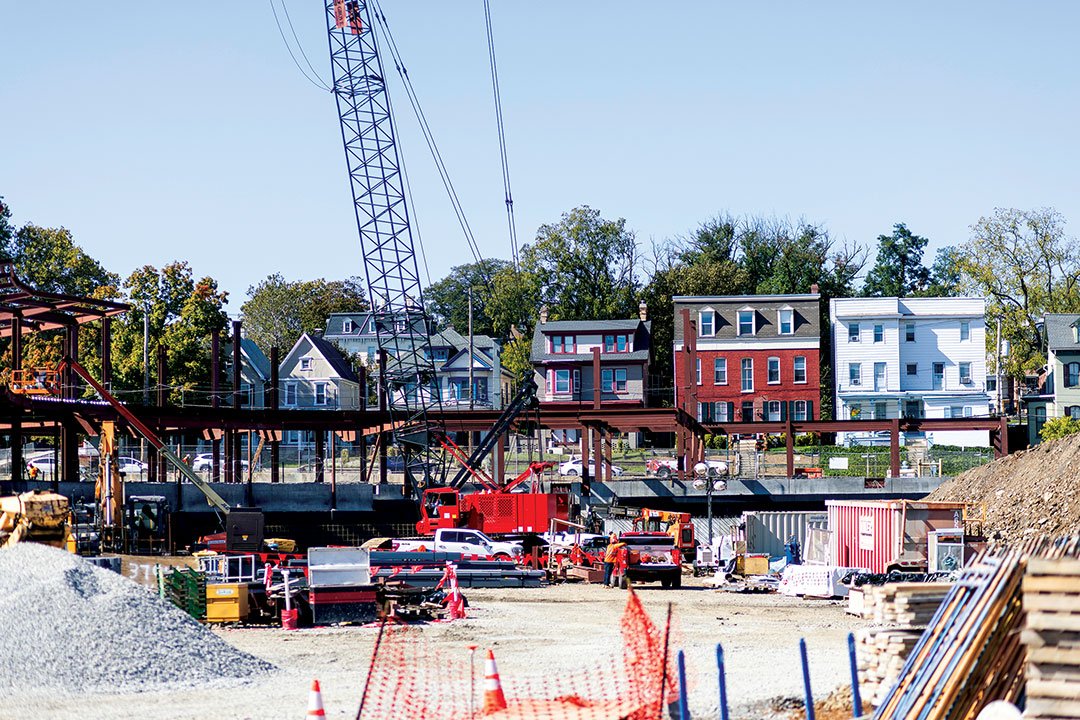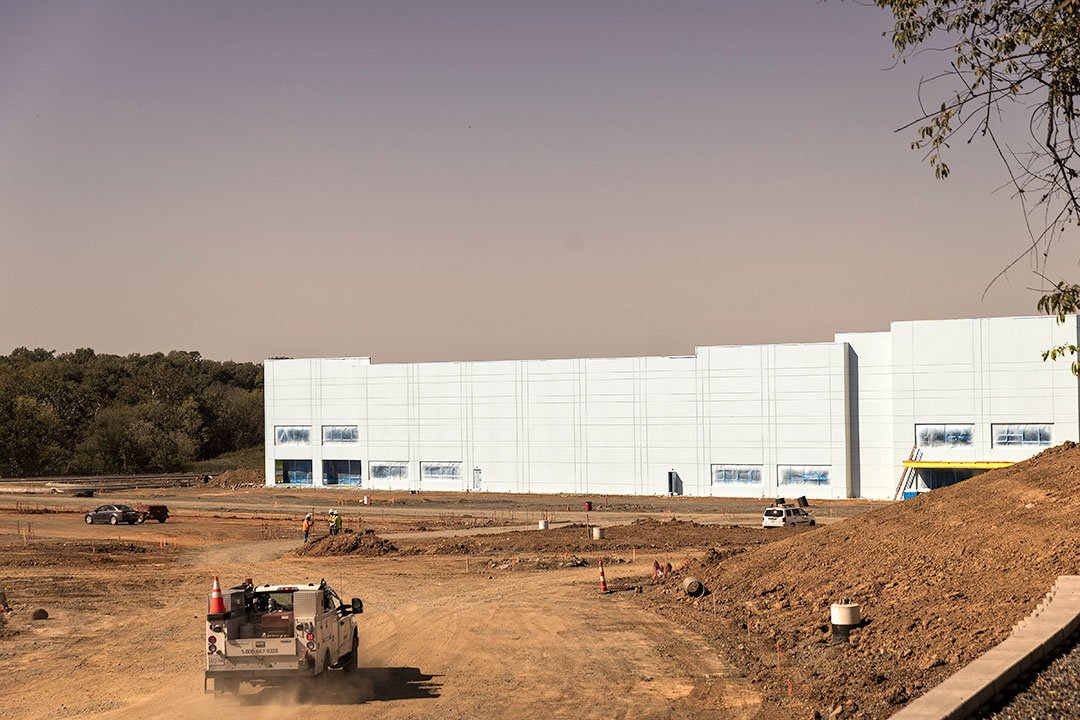A City on the Move
New public and private investment is changing the face of Hagerstown. Is this the revitalization the city has been waiting for?
By Crystal Schelle
As a native of Hagerstown, Mayor Tekesha Martinez has seen the ebbs and flows of the economic development of Hub City.
“I grew up going downtown with grandfather,” remembers the 45-year-old. “Downtown was where you’d go to get pizza. I would go to McCroy’s to get my school supplies. I remember not only Revco (Pharmacy) but the Snow White Grill, and those types of things were part of my childhood.”
Downtown Hagerstown of the ‘80s and ‘90s, saw retail businesses close and their spaces filled by government offices. Restaurants came and went. Like many downtowns across the United States, Hagerstown struggled.
Martinez, who was elected to the Hagerstown City Council in 2020, and then named mayor in 2023, has a front-row seat to the town she’s known so well as it grows and expands.
“This has not been a four- or three-year project,” she says. “This has been a strategic plan to bring Main Street back, and all these things back to downtown. It feels amazing.”
Hagerstown and Washington County officials had the foresight to plan for the future. Jill Thompson, director of Hagerstown’s Department of Community and Economic Development, says planning for Downtown Hagerstown redevelopment and establishing the Community City Center Plan started in 2014.
“There is momentum in implementing that plan as well as momentum in investor confidence,” she says.
The new downtown Hagerstown ballpark at East Washington Street and Summit Avenue.
And, Thompson says, even before the 2014 plan, downtown projects such as the University System of Maryland at Hagerstown and the rebuilt Washington County Free Library were investments in Downtown Hagerstown. Maryland’s commitment at the state level, she says, started the momentum with funding for projects like The Maryland Theatre, the Barbara Ingram School for the Arts, and the Hagerstown Cultural Trail, and, now, the Downtown Hagerstown Multi-Use and Sports Facility, or as most people would call it, a baseball park.
“And that’s part of what is causing private developers to also want to invest in downtown,” Thompson says.
The state has invested $90 million in the downtown baseball stadium at the corner of Summit Avenue and West Baltimore Street. It will be the home of the Hagerstown Flying Boxcars, a new professional team in the Atlantic League. The 3,900-seat facility is owned and operated by Hagerstown-Washington County Industrial Foundation, and the Boxcars are expected to take the field in spring 2024. It’s a project of Maryland Stadium Authority and Downtown Baseball LLC.
“I think it’s important to note that the stadium is being paid for through state funding and private ownership of the Atlantic League Flying Boxcars team and that that stadium project is not being funded with any city taxpayers’ dollars,” Thompson says.
The economic boom of the stadium can easily be seen by the supporting businesses popping up around the site, including more restaurants and boutique retail shops.
“We’re thrilled to have that project located in the core of our downtown,” Thompson says. “The economic impact of stadium projects is proven in other communities, and it attracts restaurants and retail,” she says. “It also attracts people who want to live in a vibrant downtown. So, we’re seeing growth in an upper-floor housing development that is happening. That can be attributed to that project as well as other major investments that had been happening to create a very vibrant downtown.”
Thompson says other projects such as the Hagerstown Field House on the former Municipal Stadium site off East Memorial Boulevard, will have a much bigger impact than people realize. The 114,00-square-foot sports facility with two turf fields and hardcourt space is expected to be completed by fall 2024. The city has invested $24.7 million into the project, which is a public-private partnership with Eastern Sports Management. The city will own the field house but have a lease agreement with Eastern Sports.
“The other economic impact of the Hagerstown Field House is that tournaments that are currently going to other cities will be recruited and be attracted to hold their tournaments at this facility,” Thompson says. “We will see overnight stays in our hotel hotels and visitors who will be using amenities and services in the City of Hagerstown, including dining and hospitality.”
The two million-square-foot Curwood building under construction.
Another large project is the Hub City Garage at 50 West Antietam Street, which will be downtown’s third parking deck. It will feature 397 spaces on five levels, conveniently serving the baseball fans of the new stadium. The city will operate the parking deck that saw a $13 million investment from the city’s coffers.
“Those projects have a significant impact in that without that public investment, private investments happen in the surrounding areas,” Thompson says. “And [these projects are] what creates increased property values and increased property tax revenue to the city.”
Brittany Arizmendi, came aboard the City of Hagerstown a year ago as the community engagement officer after previously working for the county for four years. Arizmendi led rebranding efforts to lead the city to its known identity of Downtown Hagerstown, including a #DowntownHagerstown campaign.
Arizmendi said when she came aboard, the stadium project and the field house were already in discussion, as was the Hub City Brewing in the former Farmer’s Market building at 25 West Church Street. Projects like these would bring more restaurants and more boutique retail space downtown.
Arizmendi’s job is to get people to come downtown, and she says projects like the stadium will put feet on the streets.
Paving the entrance road to the Curwood building as construction nears completion.
“It will help change the perception, and what I consider an inaccurate perception, of downtown,” she says. “It will get people from our more suburban areas coming down here and having good experiences and restaurants on the streets all across the board.”
Getting more people downtown might mean more people invested in the city. In 2023, 74 events were held downtown, and those were just events that were city-hosted or city-sponsored, according to Arizmendi.
“To have a vibrant downtown, you have to have people who live down here and can walk to restaurants, the shops, and invite their friends to come downtown with them who may not live in (downtown Hagerstown) but are maybe 10 minutes away,” Arizmendi says. She adds that with all these construction projects currently underway, Hagerstown is on its way to being that “vibrant downtown,” which will bring change.
“I think within the next year, what downtown looks like will be completely different,” she says. “I think we are starting to see a change, but I’m not sure we’re quite there yet.”
Projects that ever-so-slightly skirt Hagerstown city limits, like the Meritus School of Osteopathic Medicine off Robinwood Drive east of Hagerstown, are also contributing to changing the complexion of the area.
The 200,000-square-foot state-of-the-art medical school will welcome its first full class of 90 students in the fall of 2025. Eventually, the school hopes to have 720 students. Because of its proximity, the medical school should have a large impact on Hagerstown itself.
Thompson says the medical school will give Hagerstown “an opportunity to be able to attract the medical and health sciences field. And I think, downtown and even outside of downtown, the growth in the medical and health sciences field will be one we will work to foster.”
Jonathan Horowitz, director for Washington County’s Department of Business Development, said the medical school is “by far a landscape game-changing community-changing project.”
The new medical school would mark the only fourth such school in the state, while nearby West Virginia only has two medical schools throughout the state.
“While Maryland graduates some of the world’s best doctors, we also graduate the fewest,” Horowitz says.
An economic impact study shows the proposed Meritus school could eventually bring 1,595 jobs to Hagerstown and create an estimated tax revenue of $6.2 million. When the school is fully up and running it could add more than $120 million a year to Maryland’s gross domestic product.
“We know that health, education, and the economy are all connected. Improving the economy of our region also enhances the health and wellness of our neighbors,” says Dr. Maulik Joshi, Meritus president and CEO. “We are thrilled to have a project that will improve and enhance so many important factors related to the quality of life in Washington County.”
Two images of construction of the new Meritus School of Osteopathic Medicine as work progresses.
And, says Horowitz, having a medical school “where you would have not anticipated (one) to be, is such a massive change for here.” “It will draw a different type of inhabitant to this community in general.”
Hitachi Rail is building a $70 million train factory and 800-yard test track on a 41-acre site on Greencastle Pike west of Hagerstown. The factory will build new rail cars for the Washington, D.C., Metro system. Operations are expected to begin this winter. The facility is estimated to bring 430 jobs.
“Hitachi Rail obviously is a massive indicator of the strength of our community,” Horowitz says. “I think more along the lines of indications is what that name brand would bring. That goes to show you that all of the assets of this community can provide, and that means land cost, workforce, utility prices, incentives, all those things go together to attract somebody like that here.”
Horowitz says it will also have an economic impact on Hagerstown because the company has left room to expand.
“Manufacturing is our bread and butter here,” he says. “We would prefer to see that. It has better-paying jobs and a little bit more longevity, in our opinions.”
But one aspect that has people talking is the warehouses in Hagerstown and throughout the county.
“The warehouse development that you see in Washington County, is, quite frankly, 20 years of development,” Horowitz says. “It was on our 20-year comprehensive plan, and we zoned the land and highway interchange for those types of development. We didn’t zone it for COVID e-commerce focus. We did not think that almost all of the land would be purchased and developed in a three-year span.”
Horowitz says what his department does is work mostly to diversify the industries.
“So even though a lot of these big buildings were built, and they look like warehouses, what we’re trying to do is diversify the clients that take leases on these buildings,” he says.
In early October, Conair, best known for hair dryers, curling irons, and kitchen appliances, plans to lease a 2.1-million-square foot, soon-to-be-constructed facility at 10440 Downsville Pike and 17250 Sterling Road. The site will be a distribution center. The warehouse will become the largest in Maryland and the largest in the nation for small appliances. The new facility will create 700 full-time jobs over the next 10 years.
As for Hagerstown’s future, Thompson sees it as a place where economic growth can flourish.
“I hope someday in the future, downtown condominiums will make downtown a 24-hour downtown,” she says, “so it is no longer just a commercial district with your daytime users and your evening users, but you’d have people living downtown who make it a full neighborhood commercial district that really has activity 24 hours a day.”





